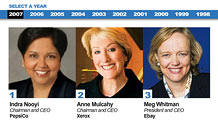A job that lets you pick your own bossW. L. Gore & Associates, the $2.3 billion maker of Gore-Tex fabric and Glide dental floss, has a very unique -- and successful -- management style.(Fortune) -- No formal job titles. Compensation and promotions determined by a group of peers, who rank each other's performance. Manufacturing plants that don't get any larger than 250 employees. It sounds like a mini-Politburo -- or at the very least, a tiny dot-com that doesn't know any better. Instead, it's the way W. L. Gore & Associates, a $2.3 billion maker of such products as Gore-Tex fabric and Glide dental floss, has operated for almost 50 years. And now that other companies are rushing to bring innovation into an equation long dominated by cost, the privately-held Gore, No. 10 on Fortune's 2007 Best Companies to Work For list, looks rather prescient.
Interactive graphic
In honor of the 10th edition of Fortune's Most Powerful Women list, we're looking back at who made the top 3 each year.
See them all "We kind of chuckle about it." says President and CEO Terri Kelly. Interviewed at Fortune's Most Powerful Women Summit, where she co-hosted a panel on innovation, Kelly shared some of Gore's unusual approach to innovation and culture. Start with leadership, which at Gore is not the normal command and control approach. "Leaders are not in charge," says Kelly, a 24-year veteran of the company who started as a process engineer and became CEO in 2005. What she means by this is that at Gore, a leader's job is not to make an individual decision, but rather, to act as the representative of the 10-or-so member team that is the basic management unit at Gore. Leaders are not appointed from above, but rather are elected from within their own team. It can be confusing for new people used to looking to their boss for guidance, but Kelly says that the fact that people choose their own leader means that things will actually get done. After all, no one is forcing anything -- or anyone -- down someone's throat. "People gravitate to their leaders," she says. "They emerge." For Kelly, one of the few at Gore with a formal title (nearly everyone else is an "associate,") leadership is more about recognizing and communicating a decision already made than barking out orders. When it comes to new product innovation, for example, the ultimate decision is rarely hers. "When projects get killed," she says, "It's the team that decides to kill them." Gore also bucks the conventional wisdom when it comes to production. Although the company manufacturers a vast range of products ranging from medical devices to guitar strings, it limits the size of the employee base at a plant to approximately 250 workers -- shockingly small for an 8,000-employee company. Kelly's philosophy, like that of Gore's founders before her, is that the cost savings from large plants is cancelled out by the loss of efficiency and productivity that comes from employees not knowing each other well. "You have to divide," she says, "So that you can multiply." Performance, too, is determined by committee at Gore, in a process that makes 360-degree feedback seem like a walk in the park. Every year, each team ranks every member relative to all of the others on the following question: "Who has made the biggest impact on the enterprise?" Kelly says the question is deliberately left undefined, so that some people interpret it as being about managing others, while others see it in terms of new products, revenues growth, or innovation. All of the rankings are sorted through by a group of "contribution committees," who use the rankings as a basis for compensation. The process, called "impact times effectiveness," works, says Kelly, because it feels fair. While all of these processes sound a bit convoluted, Kelly says the result is a freer, more innovative and flexible workforce. And the results seem to bear her out: Although Gore is private, it has been growing revenues consistently at a 7-9% rate for the last decade. And voluntary turnover at the company is just 5% -- a strikingly low number for an industrial company with many manufacturing units. Bosses, take note. |
Sponsors
|

